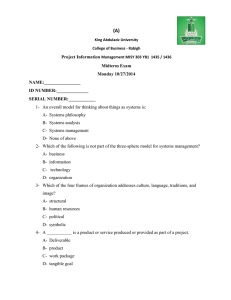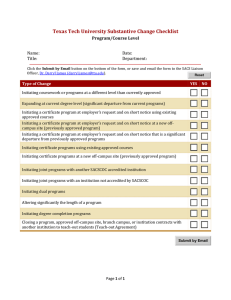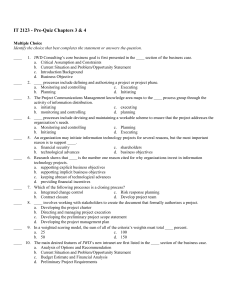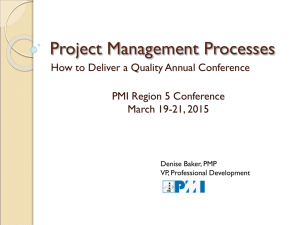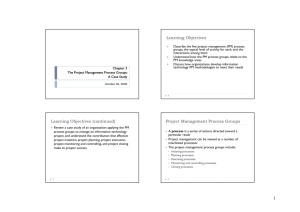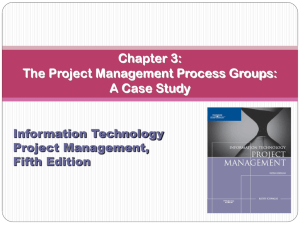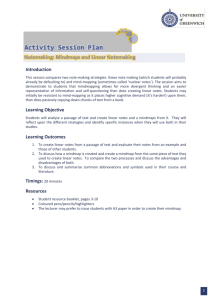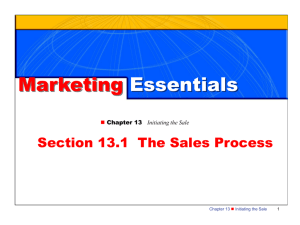Project Management Basics
advertisement
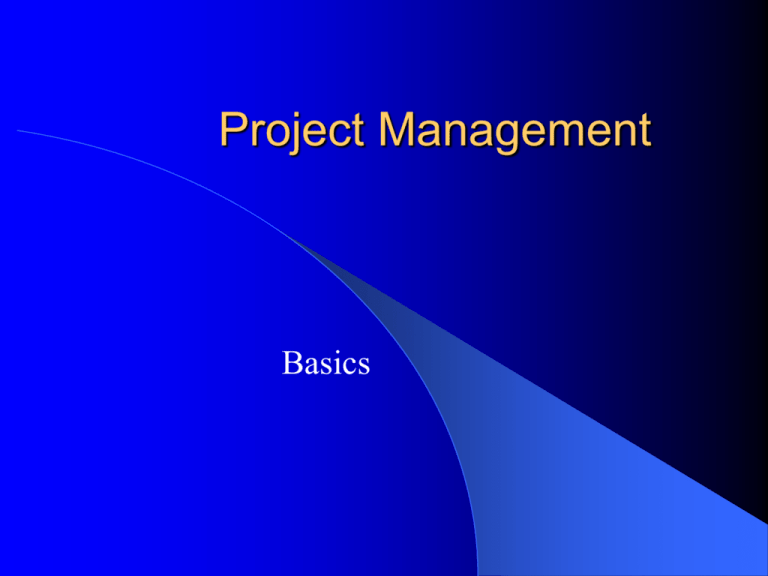
Project Management Basics 5 Phases Initiating Planning Executing Controlling Closing Initiating Recognizing that a project is worth doing – It is easier to complete projects if we are enthusiastic about them and if they match our personal values Values Balancing – A job not worth doing is not worth doing well – What is the feasibility? – What is the risk? Values Identification: Values tell us why we do what we do-they are the underlying motivators What are the qualities that make your life better? What helps you survive, thrive and prosper? What would you like to have more of in your life? What would you miss if it was eliminated from your life? What qualities define the person you want to be? The Value Wheel Determine your current ideal performance for each value listed Rate your current actual performance and place a dot by the appropriate number Connect the dots Initiating (cont.) Defining the overall project goal – Vision – Must be clearly defined Determining what the project should accomplish – The importance of creativity in PM Mindmapping Vision Purpose pulls us in the direction we want to go Exercise – Write a one-sentence vision statement for your life, based upon the values identified previously Key Criteria for Setting Goals Be specific Be realistic Have a time component Be measurable Be agreed upon Identify responsibility for achieving Mindmapping 2 Rules: 1. There are no bad ideas 2. There are no wrong mindmaps Uses include to do lists, brainstorming, task analysis, vacation planning, decision making, etc. Mindmap Steps 1. 2. 3. 4. 5. 6. 7. 8. Lighten up—brain dump Think fast-capture ideas quickly Judge not-write down everything that comes to mind Break Boundaries-don’t write neatly on paper Center first-don’t use just one side of your brain Free associate-branch off of other ideas Keep moving-the bigger the paper the more ideas Allow organization-later Mindmap Exercise How can we make the education system work better? INITIATING(cont.) Defining general expectations of stakeholders Defining the general project scope – Productivity pyramid Selecting the initial members of the project team Scope The size of the project Key is balancing scope versus complexity Tends to creep Productivity Pyramid Values – The why Long range goals – Surface problems – Trust – No limitations – The what BOEING 777 Example Intermediate Steps – The how Daily tasks – The now Video Selecting the Team Planning team – Prepare the project plan – Supervisory and technical subject matter experts – Define resource and technical requirements Core team – Specific functional areas – Stakeholder analysis PLANNING Refining the project scope – Balancing time, resources, results Time Management-Ch. 4 Day planners/consistency of purpose Listing tasks and activities that lead to achieving project goals – VPIC Visualize/Plan/Implement/Close “You can’t prioritize a stack” Planning (cont.) Sequencing activities in the most efficient manner possible – What needs to be done – When it needs to be done – Hunks chunks and bites-break it into manageable pieces – Where the information is stored – Who is responsible for each phase – Identify possible hot spots – Failsafe retrieval Planning-Same time, same place Work breakdown structure (WBS) – Defines the project work in specific tasks Responsibility matrix – Defines organization, key individuals and their responsibilities Events and Milestones – Identifies critical points and major occurences on the project schedule Gantt charts – Display the MPS and detailled task schedules PLANNING (cont.) Developing a workable schedule and budget – Backward and forward scheduling Getting the plan approved by appropriate stakeholders Organizational inertia – CQ quotient (collaborative/not) p. 224 IMPLEMENTATION “Clutter sucks creativity and energy from your brain!” Leadership – Kick off meeting Meeting with team members – delegation Communications – Trash/information/action item Delegation Authority-the person doing the task must have the authority to accomplish it B. Responsibility- shared by both parties C. Commitment- to achieving the end result in the agreed upon time frame A. “Success is the ability to go from failure to failure without losing your enthusiasm.” Projects are long-term important but not short-term urgent. IMPLEMENTATION(cont.) Installation/training/repair Preventative maintenance systems Back up systems/disaster and recovery Fire fighting Securing necessary resources – Authority – Responsibility – Commitment Interuptions Prioritize the interuption Swap offices Work in a conference room Leave the office Work at home Put up a ‘do not disturb’ sign Work in 20-30 minute chunks CONTROLLING Monitoring deviation from plan – Critical path – Reliability-if after repeated samplings, you achieve results that are close to each other – Validity- are we really measuring what we think we are? Project review meetings Corrective action – Crashing Cost Risk Evaluating change requests Project Review Meeting What has happened so far? What still needs to happen? What problems, if any, are we having? CONTROLLING(cont.) Rescheduling Adapting resource levels Changing scope Readjustment of goals if necessary CLOSING Disbanding the team Learning post-mortem Review of outcomes Final report Celebrate!!!

